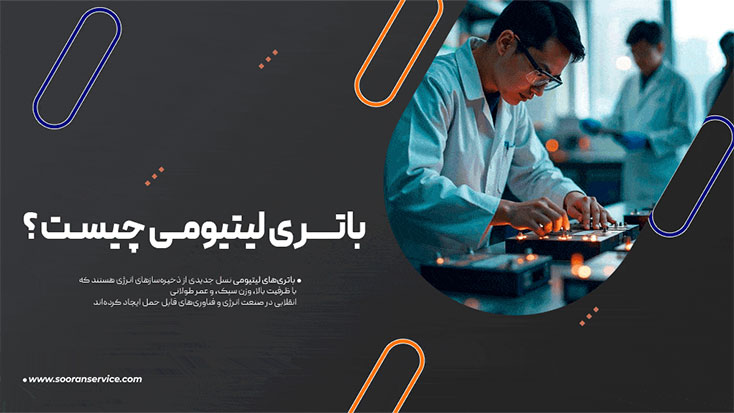In today’s world, lithium batteries are among the most important and widely used types of batteries.
Due to their lightweight design, high capacity, and long lifespan, they are used in a variety of electronic devices — from mobile phones and laptops to electric vehicles.
To better understand what a lithium battery is, it’s important to note that, thanks to lithium-ion technology, these batteries can store significantly more energy compared to traditional batteries.
This advantage has made them a key component in the advancement of sustainable technologies and the reduction of dependency on fossil fuels.
In this article, we’ll explore the definition, unique features, and applications of lithium batteries to understand why this technology has become one of the most vital elements in the modern electronics industry. Stay with us as we dive deeper into the world of lithium batteries.
Why Lithium Batteries?
A lithium-ion battery is a type of rechargeable battery that uses lithium ions as the primary active material.

because of their higher efficiency and shorter charging time compared to traditional batteries such as nickel-cadmium (NiCd) or nickel-metal hydride (NiMH) batteries.
Additionally, these types of batteries perform well under various temperature conditions, and due to their high energy density, they are ideal for devices that require storing more energy in a compact space.
Components of a Lithium Battery
A lithium battery consists of several key components, each playing an important role in its performance and efficiency.
The main parts include:
1. Negative Electrode (Anode):
The anode stores lithium during the charging cycle and releases it during discharge. In lithium batteries, this part is usually made of lithium carbon (graphite).
2. Positive Electrode (Cathode):
The cathode acts as the site for storing anions and absorbs lithium ions from the anode during charging.
It is typically made from chemical compounds such as lithium cobalt oxide (LiCoO₂), lithium iron phosphate (LiFePO₄), or lithium nickel manganese cobalt (NMC).
3. Electrolyte:
The electrolyte facilitates the transfer of lithium ions between the electrodes during the charging and discharging process.
It serves as a medium for ion transport and usually consists of lithium salts dissolved in organic solvents.
4. Semi-permeable Membrane (Separator):
The separator is placed between the positive and negative electrodes to prevent direct contact and short-circuiting.
It is typically made from materials such as polyethylene (PE) or polypropylene (PP).
5. Casing:
A lithium battery is usually enclosed in a case made from scratch- and impact-resistant materials that also provide protection against pressure and heat.
By combining these components, lithium batteries can efficiently store and deliver electrical energy, making them ideal for use in a wide range of electronic devices.
In addition to these, about 20 more materials and additives are used in manufacturing lithium-ion cells — from advanced coatings to high-tech components — to achieve batteries designed for specific applications
Features of Lithium Batteries
Lithium batteries possess unique characteristics that have made them essential in many modern electronic and industrial applications.
Some of the key features include:
High Energy Density:
They can store a large amount of energy in a small volume or lightweight structure, making them ideal for portable devices like smartphones and laptops.
Long Lifespan:
Lithium batteries typically last longer than traditional batteries and can endure many charge–discharge cycles with minimal performance loss.
Fast Charging:
They recharge quickly — one of the reasons users prefer them for modern electronic devices.
No Memory Effect:
Unlike nickel-cadmium batteries, lithium batteries are not affected by the “memory effect,” meaning their capacity does not decrease significantly due to partial charging.
Stable Performance at Various Temperatures:
These batteries perform well across a wide range of temperatures, making them suitable for industrial and electric vehicle applications.
Low Self-Discharge:
Lithium batteries retain their charge for extended periods when not in use, making them perfect for devices that don’t require constant charging.
Lightweight:
Their lightweight nature reduces the overall weight of devices — a major advantage for portable electronics and electric vehicles
How Does a Lithium Battery Work?
A lithium battery stores and releases energy through the movement of lithium ions between two electrodes. This process is made possible by the battery’s internal structure.
As mentioned earlier, a lithium battery contains two main electrodes:
the cathode (positive electrode) and the anode (negative electrode), separated by an electrolyte that allows lithium ions to move between them.
During charging, lithium ions move from the cathode to the anode and are stored there.In this phase, electrical energy is converted into chemical energy and stored within the battery.
When the battery discharges, lithium ions flow back from the anode to the cathode, generating electrical current. This current flows through the circuit and powers the connected device — effectively converting chemical energy back into electrical energy.
This continuous cycle of charging and discharging enables lithium batteries to power a wide range of devices, including mobile phones, laptops, and electric vehicles.
Conclusion
In conclusion, we hope this article has provided a clear and complete answer to the question:
“What is a lithium battery?”
As discussed, lithium batteries — thanks to their outstanding features such as high energy capacity, fast charging, and long lifespan — have become an essential part of everyday life.
These batteries have not only enhanced the efficiency of small electronic devices but also play a crucial role in larger industries such as electric vehicles and energy storage systems.
With continuous advancements, lithium battery technology continues to drive innovation, shaping a more sustainable and energy-efficient future.
For more information, feel free to contact us and receive detailed guidance from our experienced experts.




No comments yet.